This is a completed report, last modified 2004-06-17.
This document may be updated during the life of the SWAD-Europe project to reflect or link to further developments in this area.
Comments on this document are welcome and should be sent to the public-esw@w3.org list, archived at http://lists.w3.org/Archives/Public/public-esw/. General discussion of semantic web tools and technologies should be sent to www-rdf-interest@w3.org which is archived at http://www.w3.org/Archives/Public/www-rdf-interest.
This report describes a tool created to generate machine-readable descriptions of several aspects of images, using client-side javascript to consult multiple remote database-driven services to offer the user choices of objects to include in the file. The data created with this tool can be aggregated and searched in multiple dimensions - by person, date, event, type of thing, author, license; an example of such an aggregator is the Codepiction search tool [CodepictionSearch], developed as part of the FOAF project [FOAFProject].
The aim of this workpackage (WP9) [WP9] was to describe an implementation of a tool to assist in authoring (from WP9's description):
"Authoring content that is accessible requires the author to provide some information in multiple formats. For example it is important to illustrate content with appropriate multimedia for people with disabilities that affect their ability to read text. It is also important that the content of this multimedia is accessible to people who cannot see it, or cannot hear it, or perhaps both. Rather than creating all information twice, in many cases it is possible to use existing material, and to find or provide a version in a particular medium. For an author who herself has a disability, it is of critical importance to find relevant materials without having to develop them in all formats."
The implementation described in this report takes the particular case of finding images to illustrate a particular topic and can be used for the quick and simple creation of machine-processable information about the image. This information can then be aggregated and searched in various ways making it much easier to find appropriate images to illustrate textual content, and conversely find textual descriptions of image content. This tool separates out the textual descriptions of the content of a photo (e.g. "looks like Bob and Alice are having a great time at the seaside") from much more structured information about which Bob and Alice you mean specifically; where the seaside was they were visiting; whether the photo contains a bucket and spade or a glass of sangria. Making it simple for these types of distinctions to be made enables much more complex and meaningful descriptions of images; and thereby better searching of images.
Image-description-related work as part of WP3 involved liaising with various commercial, academic and independent individuals and organisations to develop a common vocabulary for parts of images, and some guidelines for combining vocabularies for a particular application [W3PhotoVocabs] - the W3photo project [W3Photo], a project to annotate photos from the WWW series of conferences. The vocabulary is available [ImageParts]. A description of the liaison activity is on the ESW weblog [W3PhotoWeblog] and in the Dissemination and Use Plan [DUP]. SWAD-Europe has also held two workshops on image annotation [SWADE1], [SWADE2].
Many tools are available for Semantic Image annotation. This section describes the objectives and requirements of this tool, usecases underpinning the requirements, the functionality of the tool, and the vocabularies used.
The main objective was a tool that made the creation of RDF data about image simple and fast for all ranges of users, including those with high and low technical skills. To expand on this we created a number of brief, high-level usecases:
Applications such as Matt Biddulph's IRC bot-based conversational interface to image annotation [ImgBot], and Damian Steer's [FOAFFinger] foaffinger rendezvous-based foaf creation tool have successfully used stateful, text-based interfaces for data creation. For a trained cataloguer doing a large batch of annotation work, command-line tools can be faster to use. Hence an early version of the tool used a text-based interface based on JavaScript Shell [JSShell].
However, a significant issue for image annotation is that as the user catalogues images they need to be able to see the image. It is also useful to be able to pick from a list of thumbnail images and then annotate several; this limits the usefulness of command line or bot interfaces. In response to user feedback on the first version, a clickable version [JSPhotoAnno] was produced. The visual cues this gives makes cataloging images faster, although there are several significant problems with layout of the information.
Multiple vocabularies are used in the RDF generated by the tool, and where possible vocabularies were used which were already well-used elsewhere. More vocabularies used for image description are described on the ESW wiki [ImageVocabs].
The FOAF vocabulary is used to describe that a photo depicts a person. Hashed mailbox addresses, homepages or weblogs can be used to identify the person.
<foaf:Image rdf:about='http://w3photo.org/photos/www2003/photos/IMG_4781_2.JPG'> <foaf:depicts> <foaf:Person> <foaf:name>Libby Miller</foaf:name> <foaf:homepage rdf:resource="http://ilrt.org/people/libby"/> </foaf:Person> </foaf:depicts> </foaf:Image>
The very large Wordnet vocabulary is used to describe objects in the image, for example, dog, beer. Wordnet is a huge lexical dictionary with definitions of thousands of words. The tool uses Dan Brickley's version of Wordnet 1.6 which makes all Wordnet's nouns accessable over http, as RDF/XML, one class at a time. Several other versions of Wordnet are available in RDF/XML, and the W3C's Semantic Web Best Practices Working Group has a taskforce currently investigating how best to make it available as RDF/XML.
<foaf:Image rdf:about='http://w3photo.org/photos/www2003/photos/IMG_4781_2.JPG'> <foaf:depicts> <wn:Dog /> </foaf:depicts> </foaf:Image>
iCalendar is a file format commonly used in Personal Information Management tools (PIMs) and calendaring and scheduling applications. RDF iCalendar is an RDF transliteration of this vocabulary.
<foaf:Image rdf:about='http://w3photo.org/photos/www2003/photos/IMG_4781_2.JPG'> <foaf:depicts> <ical:Vevent> <ical:url rdf:resource='http://www.www2003.org'/> </ical:Vevent> </foaf:depicts> </foaf:Image>
Dublin Core is a very well-known vocabulary for metadata about documents, such as a the description of an image, and the creator of an image.
<foaf:Image rdf:about='http://w3photo.org/photos/www2003/photos/IMG_4781_2.JPG'>
<dc:description>description of image here</dc:description>
<dc:creator>
<foaf:Agent>
<foaf:mbox_sha1sum>289d4d44325d0b0218edc856c8c3904fa3fd2875</foaf:mbox_sha1sum>
<foaf:name>Libby Miller</foaf:name>
</foaf:Agent>
</dc:creator>
</foaf:Image>
Creative Commons [CC] is a movement "to build a layer of reasonable, flexible copyright in the face of increasingly restrictive default rules". The idea of using it for images is to make sure that the rights holders are clearly defined and identified, and the license for re-use of images and the RDF data describing them is clear.
<foaf:Image rdf:about='http://w3photo.org/photos/www2003/photos/IMG_4781_2.JPG'>
<cc:license rdf:resource="http://creativecommons.org/licenses/by-nc-sa/1.0/" />
<dc:rights>
<cc:Agent>
<foaf:name>Ben Shneiderman</foaf:name>
<foaf:mbox_sha1sum>49f9ee9630fa1b694161112d29d8e15c30344cc0</foaf:mbox_sha1sum>
</cc:Agent>
</dc:rights>
</foaf:Image>
Annotea is a vocabulary and protocol for describing annotations. Here we use the vocabulary to describe the author of the annotation and the relationship between the document containing the annotation (the RDF document), and the image.
<rdf:Description rdf:about=''> <an:annotates rdf:resource='http://w3photo.org/photos/www2003/photos/IMG_4781_2.JPG'/> <an:author> <foaf:Person> <foaf:mbox_sha1sum>49f9ee9630fa1b694161112d29d8e15c30344cc0</foaf:mbox_sha1sum> <foaf:name>Ben Shneiderman</foaf:name> </foaf:Person> </an:author> <an:created>2004-05-12T16:14:49Z</an:created> </rdf:Description>
Related tools are detailed on the ESW weblog [RelatedTools] and in the writeup of the two SWAD-Europe workshops [SWADE1], [SWADE2].
The tool is designed to annotate images that are already on the web somewhere. It allows the creation of annotations which describe the content of the image:
and also metadata about the image:
The tool builds an RDF file describing these characteristics of the image on the fly, using namespaces that are already well-used, where possible. The RDF file can then be uploaded to the web and harvested by aggregators. Here is an example of such a file, with tags from different namespaces in different colours:
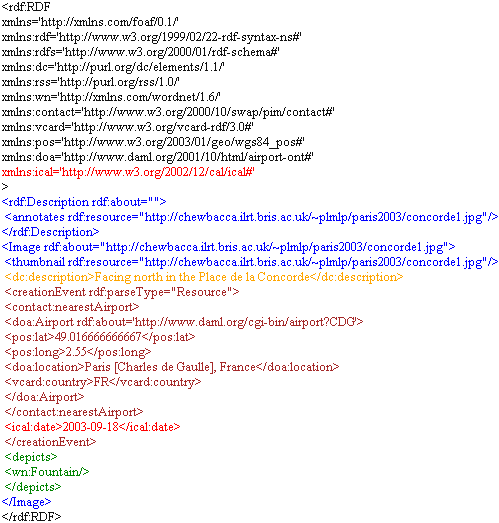
The tool uses a proxy to download 1) a page of links to thumbnails, 2) a page with images in it, or 3) a single image, into an iframe. The images are accessed using the DOM, and displayed. Clicking on an image triggers a download of the image or html page linked to in the initial thumbnails page, and then the tool uses heuristics to determine if the link is to an image or an html page. If the latter, it makes a guess about which is the correct image, and makes that the main item to be catalogued. At this stage the display shows something like this:
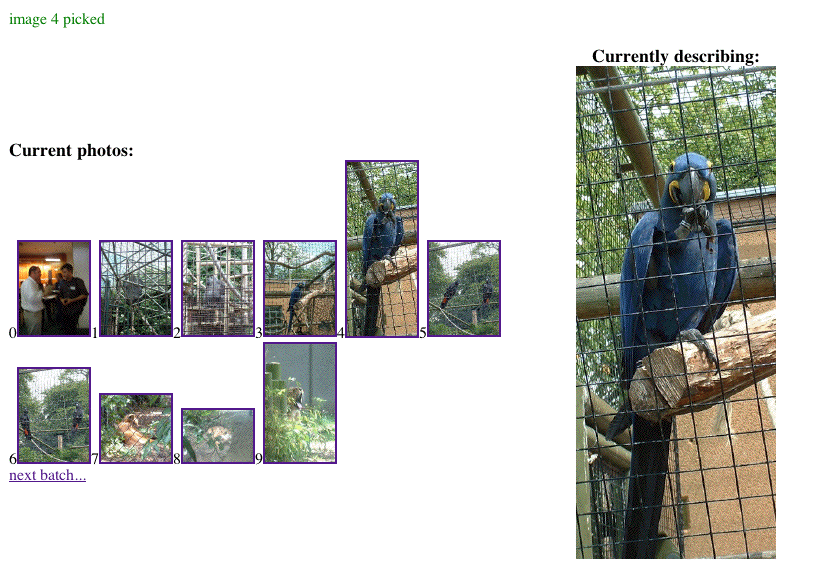
and the RDF generated looks like this:
<rdf:RDF xmlns='http://xmlns.com/foaf/0.1/' xmlns:rdf='http://www.w3.org/1999/02/22-rdf-syntax-ns#' xmlns:rdfs='http://www.w3.org/2000/01/rdf-schema#' > <rdf:Description rdf:about=""> <annotates rdf:resource="http://swordfish.rdfweb.org/photos/2003/06/12/2003-06-12-Images/4.jpg"/> </rdf:Description> <Image rdf:about="http://swordfish.rdfweb.org/photos/2003/06/12/2003-06-12-Images/4.jpg"> <thumbnail rdf:resource="http://swordfish.rdfweb.org/photos/2003/06/12/2003-06-12-Thumbnails/4.jpg"/> </Image> </rdf:RDF>
For images containing people, it is useful to be able to say that the image depicts a particular, identified person. See the codepiction experiment [CodepictionSearch] for more information about this approach.
One issue is a convenient way of finding people's sha1-encoded email addresses (or their actual email addresses and converting them using a tool). This is where a remote service from a database which already contains this information is useful. This could be, for example, a private address book with a remote interface which produces RDF. In this case, we use an interface to a harvested RDF database.
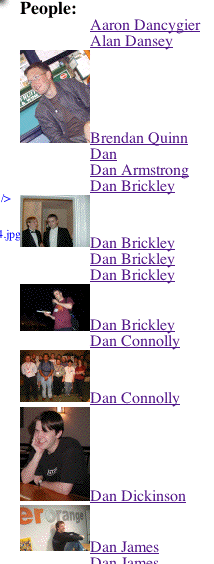
Sha1-encoded mailboxes and images are shown in response to a query on a substring of a name. Clicking on the image or the name produced adds the person to the RDF. If the person is not in the database, they can be added manually using the forms. At no time is an email address made public.
Dan Brickley has produced a service whereby appending a noun to the namespace http://xmlns.com/wordnet/1.6/ gives you the wordnet hierarchy for that noun, if it exists. The image annotating tool uses this trick, so if you type 'parrot' into the 'keyword' box, the tool uses Jim Ley's RDF parser to fetch the RDF associated with http://xmlns.com/wordnet/1.6/Parrot, and display it in a useful way so that the tool user can check that it displays the term they are interested in, and also see if a sublcass of the main term might be more appropriate.

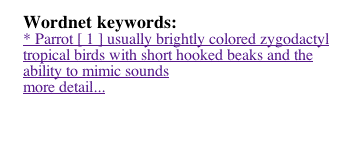
The wordnet term is then added to the generated RDF by clicking on it, for example:
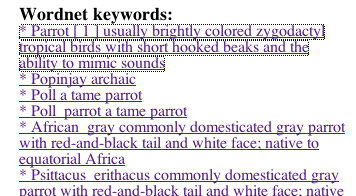
The RDF generated looks something like this:
<rdf:RDF
xmlns='http://xmlns.com/foaf/0.1/'
xmlns:rdf='http://www.w3.org/1999/02/22-rdf-syntax-ns#'
xmlns:rdfs='http://www.w3.org/2000/01/rdf-schema#'
>
<rdf:Description rdf:about="">
<annotates rdf:resource="http://swordfish.rdfweb.org/photos/2003/06/12/2003-06-12-Images/4.jpg"/>
</rdf:Description>
<Image rdf:about="http://swordfish.rdfweb.org/photos/2003/06/12/2003-06-12-Images/4.jpg">
<thumbnail rdf:resource="http://swordfish.rdfweb.org/photos/2003/06/12/2003-06-12-Thumbnails/4.jpg"/>
<depicts>
<wn:Parrot/>
</depicts>
</Image>
</rdf:RDF>
Ideally the location of a photo would come from the EXIF (EXchangeable Image Format) data the camera produces: the same goes for date. The first of these is not yet available so we have had to come up with something else. The latter is readily available, but we have not come across EXIF parsers in javascript as yet.
We have chosen to use the nearestAirport property to associate an image with location data at this time. This is because information linking airports with latitude and longitude is freely available. As an added bonus, this method preserves privacy.
The key issue in terms of accessing geo data is human-readable to lat/long mappings. As an approximation the airports data works well because there is a human-readable name for the airport which includes the nearest town or city. This means we can search on the airports data using user-inputted names of places and get out the lat/longs. A similar (and more finegrained) approach would be to use the spacenamespace data; at the moment this is UK-only however. Where GPS data is available, a good modeling idiom is that used by Morten Frederiksen [ImageVocabs].
Modeling the nearestAirport information was difficult. It is not the nearestAirport to the picture as an artifact (the picture may be held on one or more servers, well away from the location). Nor is it necessarily a picture of a location. Instead, it's the location the camera was in when the picture was taken. Similar arguments apply to the date the picture was taken. An experimental new property, creationEvent, was created to test this out. The use of creationEvent masks a hidden resource - an object representing the event, to which nearestAirport and date can be attached.
<foaf:Image rdf:about='http://w3photo.org/photos/www2003/photos/IMG_4781_2.JPG'> <test:creationEvent rdf:parseType="Resource"> <contact:nearestAirport> <doa:Airport rdf:about='http://www.daml.org/cgi-bin/airport?JFK'> <pos:lat>40.633333333333</pos:lat> <pos:long>-73.783333333333</pos:long> <doa:location>New York, NY [John F. Kennedy International Airport], USA</doa:location> <vcard:country>US</vcard:country> </doa:Airport> </contact:nearestAirport> </test:creationEvent> </foaf:Image>
Sometimes it is very useful to be able to search for all the images taken at a particular event, for example a conference or meeting. A simple way of doing this is to say that the image depicts the event, and then give the event a url. There are some difficulties with this approach: it effectively uses ical:url as an identifier for the event, and many events do not have a url, or do not have a single identifying url. Moreover, the semantics of ical:url are not quite appropriate for it to be used as an identifier - foaf:homepage might be better to use as an identifier.
<foaf:Image rdf:about='http://w3photo.org/photos/www2003/photos/IMG_4781_2.JPG'>
<foaf:depicts>
<ical:Vevent>
<ical:url rdf:resource='http://www.www2003.org'/>
</ical:Vevent>
</foaf:depicts>
</foaf:Image>
Users can also add a freetext description. This is coded as the Dublin Core description of the image. Similarly, Dublin Core date is created using a form, although it would be better excerpted from EXIF data if available.
It is important to assign rights where possible to the image and the RDF information about it created, and also important to say who the creator of the image and the author of the annotation are. This is very useful for re-using images in an authoring environment.
The tool uses Dublin Core, Annotea and Creative Commons to assign rights creation information and licensing information. Explanations of the Creative Commons licenses are available on the Creative Commons site [CC].
When complete, you can upload the RDF data to a test server, or you can copy and paste the information to your own server. If you use the test server, you cannot then edit the data. If you use the automatic uploading feature it notifies the database. If on your own server you need to notify the RDFWeb database [RDFWebDatabase] of the location of that file yourself; then that file will be harvested and its data available for querying through the codepiction interface [CodepictionSearch].
The tool is licensed using the W3C license [W3Clicense]. The UI tab component was written by Derek Anderson [JSTab] and he has allowed me to reuse his code under this license. Please read the license before downloading.
A zip of the Javascript code is available [Download].
To make the code up on your own server, you will need to create a server-side proxy, which passes html pages and images through to your server intact. This is to bypass the security restrictions in Javascript, in order to download images form any source and use them directly in the application. It means that any html or image page could appear to come from your site, so be cautious if you use this approach. A safer approach might be to use the annotator only for photos on your site.
The experimental online service just posts the RDF data to a server-side application that saves the data locally and then loads it into a database. There is no security at present, although there are checks on the validity of the RDF. If you want to implement this yourself it would be best to add password restrictions on uploads. You could create the files and then automatically add to the RDFWeb database if you like [RDFWebDatabase].
When accessing remote data, I use Jim Ley's Javascript RDF tools [JSRDFTools] to access certain remote datasources accessible over http. There is currently no way for these to advertise themselves or route queries automatically between them - they are hardcoded within the application. Here are the interfaces:
Airports using location descriptions - query for 'Bristol'
People by name - query for Libby
General RDF database interface - access using Squish Queries
[Squish] -
example for events with title like www2004.
Wordnet database - query for 'Dog'.
More useful features would be:
The tool requires that you select an image before you can create the RDF data describing it. Theoretically though, there's no reason why this tool could not be used to create RDF data about any document, any person, or any event.
Using Javascript has meant that adding new functionality cleanly and consistently has been difficult. I have separated the functionality of each tab into a different file as a start.
Morten Frederiksen has a tool allowing the user to annotate multiple photos simultaneously - e.g. all these are pictures near Bristol. However it is not clear how to add this to the user interface.
As we have seen, several different kinds of information are presented in separate boxes on the page, and these can easily overflow a single screen, and some familiarity with the tools are required before users know where the result of a query will appear. With more work on the javascript and style sheets, these prototypes could be developed into visually appealing and unintimidating services.
RDF can be used to say anything about anything, and coupled with the ability to annotate any image on the web, this could lead to both
Retaining the source of these annotations within the application and the software is therefore essential, in order to be able to remove annotations where there are privacy implications.
Further kinds of data that we might want to include in annotations include: